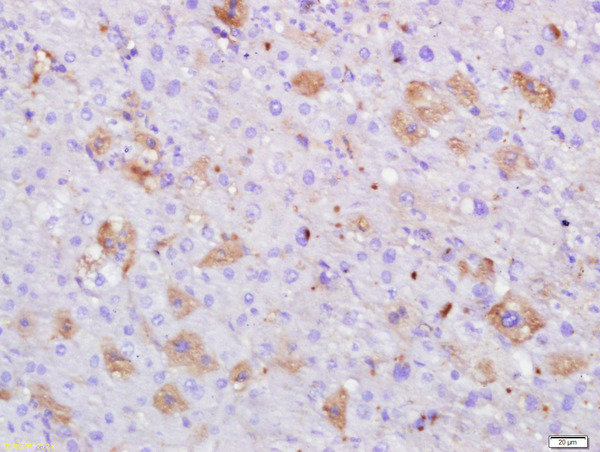Albumin antibody
GTX102419
ApplicationsImmunoFluorescence, Western Blot, ImmunoCytoChemistry, ImmunoHistoChemistry, ImmunoHistoChemistry Frozen, ImmunoHistoChemistry Paraffin, Other Application
Product group Antibodies
TargetALB
Overview
- SupplierGeneTex
- Product NameAlbumin antibody
- Delivery Days Customer9
- Application Supplier NoteWB: 1:500-1:100000. ICC/IF: 1:100-1:1000. IHC-P: 1:100-1:1000. IHC-Fr: 1:100-1:1000. *Optimal dilutions/concentrations should be determined by the researcher.Not tested in other applications.
- ApplicationsImmunoFluorescence, Western Blot, ImmunoCytoChemistry, ImmunoHistoChemistry, ImmunoHistoChemistry Frozen, ImmunoHistoChemistry Paraffin, Other Application
- CertificationResearch Use Only
- ClonalityPolyclonal
- Concentration0.45 mg/ml
- ConjugateUnconjugated
- Gene ID213
- Target nameALB
- Target descriptionalbumin
- Target synonymsFDAHT, HSA, PRO0883, PRO0903, PRO1341, albumin, serum albumin
- HostRabbit
- IsotypeIgG
- Protein IDP02768
- Protein NameAlbumin
- Scientific DescriptionAlbumin is a soluble, monomeric protein which comprises about one-half of the blood serum protein. Albumin functions primarily as a carrier protein for steroids, fatty acids, and thyroid hormones and plays a role in stabilizing extracellular fluid volume. Albumin is a globular unglycosylated serum protein of molecular weight 65,000. Albumin is synthesized in the liver as preproalbumin which has an N-terminal peptide that is removed before the nascent protein is released from the rough endoplasmic reticulum. The product, proalbumin, is in turn cleaved in the Golgi vesicles to produce the secreted albumin. [provided by RefSeq]
- Storage Instruction-20°C or -80°C,2°C to 8°C
- UNSPSC12352203
References
- Wu MC, Wang EY, Lai TW. TAT peptide at treatment-level concentrations crossed brain endothelial cell monolayer independent of receptor-mediated endocytosis or peptide-inflicted barrier disruption. PLoS One. 2023,18(10):e0292681. doi: 10.1371/journal.pone.0292681Read this paper
- Chida T, Ishida Y, Morioka S, et al. Persistent hepatic IFN system activation in HBV-HDV infection determines viral replication dynamics and therapeutic response. JCI Insight. 2023,8(9). doi: 10.1172/jci.insight.162404Read this paper
- Fujino M, Morito N, Hayashi T, et al. Transcription factor c-Maf deletion improves streptozotocin-induced diabetic nephropathy by directly regulating Sglt2 and Glut2. JCI Insight. 2023,8(6). doi: 10.1172/jci.insight.163306Read this paper
- Yuan Y, Wang C, Zhuang X, et al. PIM1 promotes hepatic conversion by suppressing reprogramming-induced ferroptosis and cell cycle arrest. Nat Commun. 2022,13(1):5237. doi: 10.1038/s41467-022-32976-9Read this paper
- Lai H, Guo Y, Tian L, et al. Protein Panel of Serum-Derived Small Extracellular Vesicles for the Screening and Diagnosis of Epithelial Ovarian Cancer. Cancers (Basel). 2022,14(15). doi: 10.3390/cancers14153719Read this paper
- Wu MC, Hsu JL, Lai TW. Evans blue dye as an indicator of albumin permeability across a brain endothelial cell monolayer in vitro. Neuroreport. 2021,32(11):957-964. doi: 10.1097/WNR.0000000000001690Read this paper
- Tu YF, Jiang ST, Chiang CW, et al. Endothelial-specific insulin receptor substrate-1 overexpression worsens neonatal hypoxic-ischemic brain injury via mTOR-mediated tight junction disassembly. Cell Death Discov. 2021,7(1):150. doi: 10.1038/s41420-021-00548-3Read this paper
- Kang HK, Sarsenova M, Kim DH, et al. Establishing a 3D In Vitro Hepatic Model Mimicking Physiologically Relevant to In Vivo State. Cells. 2021,10(5). doi: 10.3390/cells10051268Read this paper
- Wang YL, Lee YH, Hsu YH, et al. The Kidney-Related Effects of Polystyrene Microplastics on Human Kidney Proximal Tubular Epithelial Cells HK-2 and Male C57BL/6 Mice. Environ Health Perspect. 2021,129(5):57003. doi: 10.1289/EHP7612Read this paper
- Biery MC, Noll A, Myers C, et al. A Protocol for the Generation of Treatment-naïve Biopsy-derived Diffuse Intrinsic Pontine Glioma and Diffuse Midline Glioma Models. J Exp Neurol. 2020,1(4):158-167. doi: 10.33696//Neurol.1.025Read this paper






